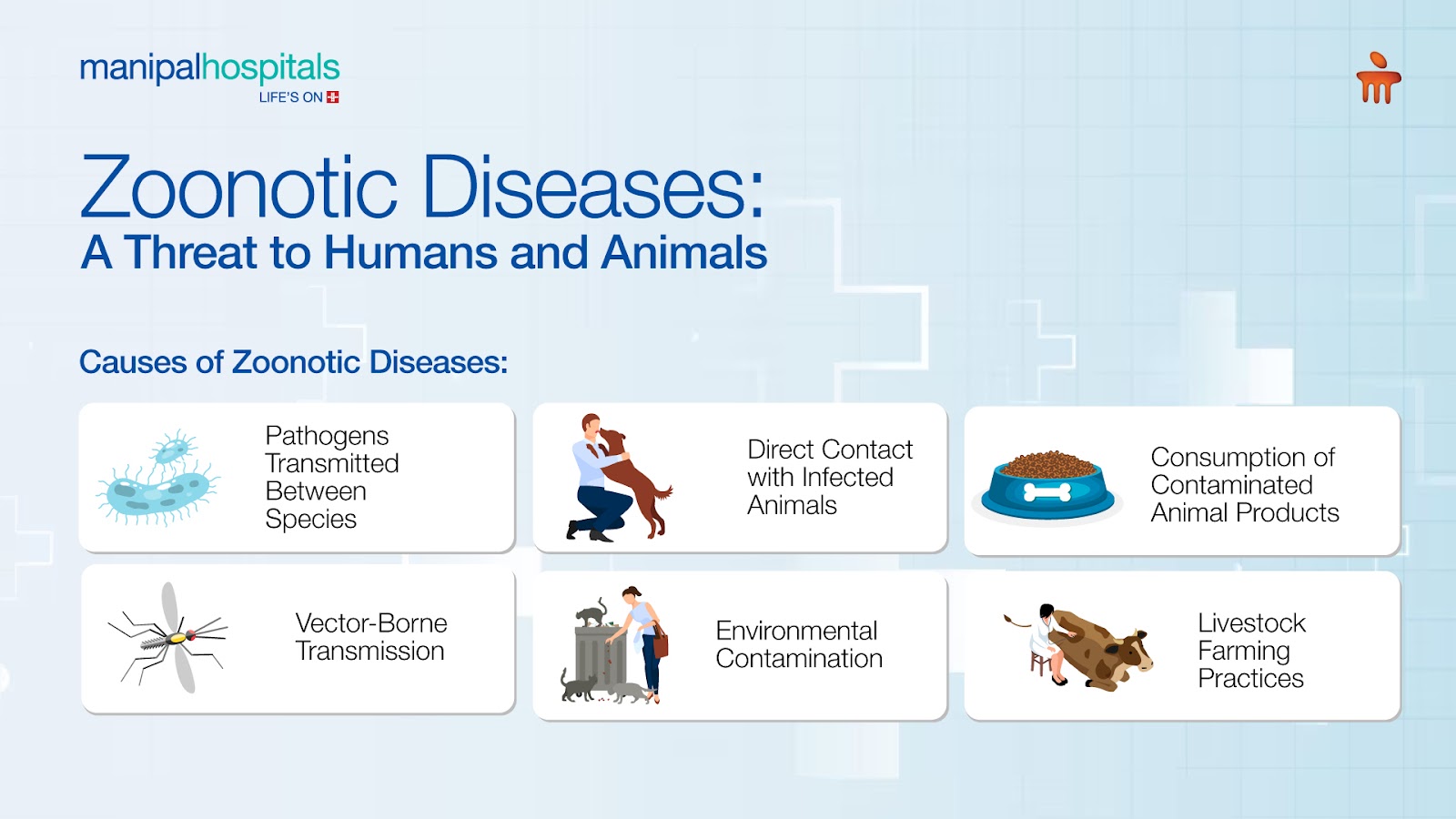
Zoonotic diseases are infections that can be transmitted from animals to humans. These diseases are caused by pathogens such as bacteria, viruses, fungi, and parasites that are present in animals. The transmission of these diseases can be through direct contact with infected animals, their bodily fluids, or their excreta. Alternatively, it can occur through indirect transmission via contaminated food, water, or surfaces.
Synopsis
Aetiology of Zoonotic Diseases
Zoonotic diseases have been a significant public health concern for centuries. The aetiology of these diseases is diverse, with various pathogens causing different types of diseases. Bacteria such as Salmonella, Campylobacter, and E. coli are common causes of foodborne zoonotic infections. These bacteria are usually found in the gastrointestinal tracts of animals and are transmitted to humans through the consumption of contaminated food or water.
Viral infections such as avian influenza, swine flu, and rabies are also common zoonotic diseases. These viruses are usually transmitted from animals to humans through direct contact or exposure to contaminated animal products. Parasitic infections such as Toxoplasmosis and Cryptosporidiosis are also zoonotic diseases. These parasites are usually transmitted through the consumption of contaminated food or water or direct contact with infected animals.
Causes of Zoonotic Diseases

-
Pathogens Transmitted Between Species
Zoonotic diseases are caused by pathogens, including bacteria, viruses, parasites, and fungi, that can be transmitted between animals and humans.
-
Direct Contact with Infected Animals
Close interaction with infected animals, either domestic or wild, can lead to the transmission of zoonotic diseases, which are diseases caused by animals to humans. This includes activities such as handling, hunting, or keeping animals as pets.
-
Consumption of Contaminated Animal Products
Eating undercooked or raw animal products, such as meat, eggs, or unpasteurised milk, can expose humans to zoonotic pathogens.
-
Vector-Borne Transmission
Some zoonotic diseases are transmitted through vectors like mosquitoes or ticks that become infected by feeding on an infected animal and then transmitting the pathogen to humans.
-
Environmental Contamination
Pathogens shed by infected animals can contaminate the environment, leading to human exposure through contact with contaminated surfaces or water sources.
-
Livestock Farming Practices
Intensive livestock farming, with animals kept nearby, can facilitate the spread of zoonotic diseases. The use of antibiotics in animal agriculture can also contribute to the development of antibiotic-resistant strains.
-
Wildlife Reservoirs
Wildlife can serve as reservoirs for many zoonotic pathogens. Encroachment into natural habitats or close contact with wildlife increases the risk of transmission to humans.
Impact of Zoonotic Diseases
The impact of zoonotic diseases on human health is significant. These diseases can cause a wide range of symptoms, from mild to severe, and in some cases, they can be fatal. Consult an infectious disease specialist at Manipal Hospitals in Bangalore if you encounter any similar symptoms, Zoonotic diseases can also have a significant economic impact. For example, outbreaks of avian influenza in poultry can lead to significant losses in the poultry industry. Similarly, outbreaks of foot-and-mouth disease in livestock can result in the culling of large numbers of animals, leading to significant economic losses.
The other impacts of Zoonotic diseases are as follows:

- Public Health Impact
Zoonotic diseases can cause a range of illnesses in humans, from mild to severe, and may lead to epidemics or pandemics.
- Economic Consequences
Zoonotic outbreaks can result in significant economic losses, affecting agriculture, livestock industries, and healthcare systems.
- Disruption of Livelihoods
In communities heavily dependent on agriculture or animal husbandry, zoonotic diseases can disrupt livelihoods and food security.
- Losses in Animal Agriculture
Outbreaks in livestock can lead to substantial losses in animal populations, affecting farmers and the agricultural sector.
- Environmental Impact
Zoonotic diseases can have environmental consequences, including changes in ecosystems and wildlife populations.
- Antibiotic Resistance
The use of antibiotics in animal agriculture can contribute to the development of antibiotic-resistant strains of bacteria, posing challenges for human medicine.
- Impact on Wildlife Conservation
Zoonotic diseases can pose threats to wildlife populations, affecting biodiversity and conservation efforts.
Prevention of Zoonotic Diseases
Preventing the transmission of zoonotic diseases requires a multi-sectoral approach that involves collaboration between public health, animal health, and environmental health sectors. One of the key prevention measures is promoting good hygiene practices, such as hand washing and proper food handling. Vaccination of animals can also help prevent zoonotic diseases. For example, vaccination of poultry against avian influenza can reduce the risk of transmission of the virus to humans. Similarly, vaccination of dogs against rabies can help prevent transmission of the virus to humans.
Zoonotic diseases are a significant public health concern, and their impact on human health and the economy is significant. Preventing the transmission of these diseases requires a multi-sectoral approach that involves collaboration between public health, animal health, and environmental health sectors. Promoting good hygiene practices and vaccination of animals are key prevention measures. By working together, we can reduce the burden of zoonotic diseases and improve the health and well-being of both humans and animals.
FAQ's
Zoonotic diseases are infections that can be transmitted from animals to humans. These diseases are caused by various pathogens such as bacteria, viruses, fungi, and parasites that animals carry.
Zoonotic diseases can spread to humans through direct contact with infected animals, their bodily fluids, or excreta. Indirect transmission can occur via contaminated food, water, or surfaces.
Zoonotic diseases can be caused by bacteria (Salmonella, E. coli), viruses (avian influenza, rabies), parasites (Toxoplasmosis, Cryptosporidiosis), and fungi. These pathogens are often found in the gastrointestinal tracts or bodily fluids of animals.
Intensive livestock farming, close animal proximity, and the use of antibiotics can facilitate the spread of zoonotic diseases. Additionally, contaminated animal products can lead to human exposure.
Zoonotic diseases can cause a wide range of symptoms in humans, from mild to severe, and may lead to epidemics or pandemics. Economically, they can result in significant losses in agriculture, livestock industries, healthcare systems, and disrupt livelihoods and food security in affected communities.






















 4 Min Read
4 Min Read










